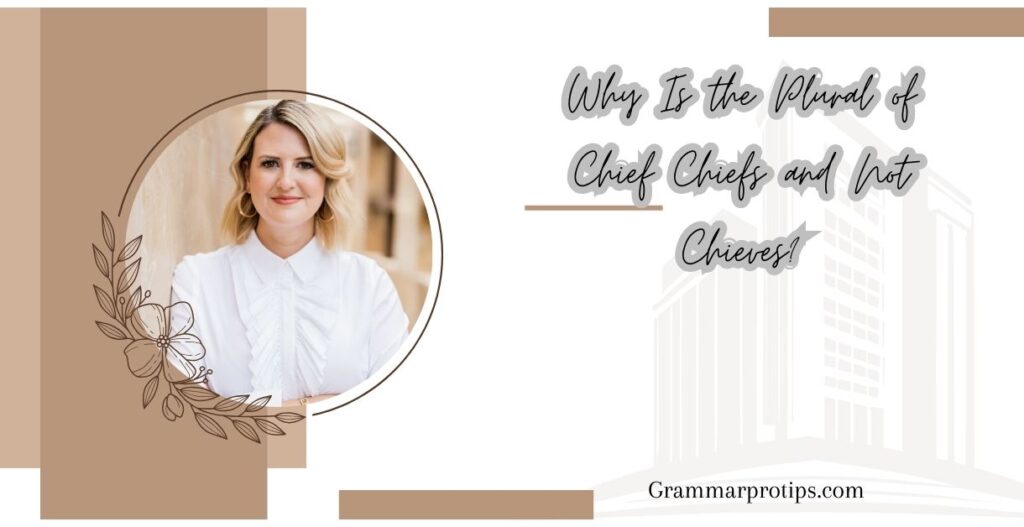The English language, with its multitude of rules and exceptions, can sometimes be a tricky thing to navigate.
One of the most common sources of confusion is pluralization—especially when it comes to irregular words. One word that often causes people to pause is chief. So, what is the plural of chief?
What is the Plural of Chief?
When it comes to pluralizing nouns in English, there are a variety of rules and patterns to follow. However, there are always exceptions. The word chief is no exception to this trend.
The plural of chief is “chiefs.”
That’s right, chiefs with no “v” is the correct plural form. This might seem a bit counterintuitive to some people, especially when considering other English words that end in “f.” There are instances where an “f” turns into a “v” when pluralized, such as leaf becoming leaves, or calf becoming calves. However, in the case of chief, it is an exception. There’s no need for that “v” change.
Why Is the Plural of Chief Chiefs and Not Chieves?

One might wonder: Why is the plural of chief “chiefs” and not “chieves”? It’s a fair question, and the answer lies in how the word chief has evolved in English. The word chief comes from the Old French word chef, which means “leader” or “head,” and was adopted into English. Over time, English speakers retained the spelling and did not follow the pattern seen in some other words that end in “f.”
Chief Plural: A Breakdown of Rules and Exceptions
Before we dive deeper into chief and its plural form, let’s take a quick look at some English pluralization rules.
General Rule for Words Ending in -f
Typically, words that end in -f or -fe change to -ves in the plural form. Examples include:
- calf → calves
- wolf → wolves
- leaf → leaves
However, the plural of chief does not follow this rule. It remains chiefs, and this is simply an exception to the general pattern.
Exceptions to Pluralization Rules in English
English is a language full of irregularities, and chief is one of those irregular cases. Some words that end in “-f” do follow the typical pattern of changing the “f” to a “v” in the plural, while others like chief simply don’t.
It’s important to remember that there isn’t always a consistent logic behind every English exception, which can make learning the rules even more challenging!
Examples of Chiefs in Context: Emails, Reports, and Real Life Scenarios
To better understand how chiefs is used in practical scenarios, let’s look at some examples in the form of emails, reports, and real-life situations.
Example 1: Email to the Department Chiefs
Imagine you’re writing a formal email to several department heads in a company:
Subject: Quarterly Department Chiefs Meeting
Dear Mr. Jenkins, Mrs. Smith, and Ms. Robinson,
I hope this email finds you well. I wanted to remind all of you that the quarterly meeting with the department chiefs will take place next Tuesday at 2:00 PM. Please ensure you have your reports prepared in advance, as we will be discussing the upcoming budget allocations.
If you have any specific topics you’d like to include in the agenda, feel free to send them to me by the end of the day on Monday.
Looking forward to seeing you all at the meeting.
Best regards,
John Doe
Chief Operating Officer
Here, the term “department chiefs” is used to address the plural of the word chief. The plural form fits naturally in the sentence, as we’re discussing multiple heads of departments.
Example 2: Report on Military Chiefs
Another context where you might see the word chiefs is in a military setting. Here’s how it could appear in a report:
Title: Annual Review of Military Chiefs’ Operations
In this year’s review, we assessed the contributions of various military chiefs in the strategic planning and execution of operations. These chiefs oversee the command structure of different branches, and their decisions have significant impacts on national security.
The leadership provided by these military chiefs has been invaluable, especially in the context of evolving global threats.
Here, the word chiefs clearly refers to the plural of chief, specifically military leaders, highlighting the importance of correct plural usage in formal reports and military settings.
Understanding the Plural of Chief in Specific Contexts

The use of the word chief is not limited to just leaders in business or military contexts. The term can also appear in various other settings such as chiefs of staff, regional chiefs, and more.
Plural of Chief of Staff
In a government or corporate setting, the chief of staff is a key position. The plural form of this phrase is chiefs of staff.
For example:
- “The chiefs of staff from various departments met to discuss new organizational strategies.”
Plural of Handkerchief
The plural of handkerchief is handkerchiefs, not handkerchieves.
Plural of Dwarf
In this case, the plural is dwarfs, though the term dwarves is also used in fantasy literature.
Plural of Roof
For roof, the plural is roofs, not rooves.
Plural of Sheep
The plural of sheep remains sheep. No change.
Plural of Belief
The plural of belief is beliefs.
Plural of Donkey
The plural of donkey is donkeys.
Synonyms and Related Terms to Chief
While chief refers to a leader or head of an organization, there are many synonyms depending on context. Some alternatives include:
- Leader
- Head
- Director
- Commander
- Boss
- Executive
These terms, while similar, may carry slightly different meanings based on the context in which they’re used.
The Linguistic Roots of the Word Chief

The word chief derives from the Old French chef, which itself comes from the Latin caput, meaning “head.” It originally referred to someone in a position of authority, particularly as the head of a group, tribe, or organization. Over time, it became synonymous with the concept of leadership across various fields.
Chief in Emails and Reports
When drafting emails or reports, using the word chief in its plural form, chiefs, can be crucial in ensuring clarity and proper respect for those in leadership roles. Whether referring to department chiefs, military chiefs, or chief executives, it’s vital to use the correct pluralization to maintain professionalism and precision in communication.
For instance, in a business context:
- “The chiefs of each division were invited to the meeting.”
In a governmental or military context:
- “The military chiefs were called to discuss national defense strategies.”
Conclusion: The Correct Plural Form of Chief
To wrap up, it’s important to remember that the correct plural of chief is chiefs. Despite some exceptions to English pluralization rules, chief does not follow the “change the f to v” rule. Understanding this distinction is key to mastering proper English usage in both formal and informal settings.
The next time you need to refer to more than one chief, whether in an email, report, or conversation, you’ll know that the right form is chiefs, not chieves.
Table: Common English Noun Plurals
| Singular | Plural |
|---|---|
| Chief | Chiefs |
| Handkerchief | Handkerchiefs |
| Leaf | Leaves |
| Wolf | Wolves |
| Calf | Calves |
| Dwarf | Dwarfs |
| Roof | Roofs |
| Sheep | Sheep |
| Belief | Beliefs |
| Donkey | Donkeys |
In conclusion, whether you’re dealing with business chiefs, military chiefs, or chiefs of staff, remember that the plural of chief is always chiefs. Mastering these small details will ensure you’re communicating clearly and professionally in your English writing.

“Smith is the dedicated admin of [grammarprotips.com], a platform focused on enhancing grammar skills. With a passion for language and education, Smith strives to make grammar accessible and enjoyable for learners of all levels. Committed to delivering high-quality content, Smith continually explores innovative ways to help users master the complexities of grammar.”

